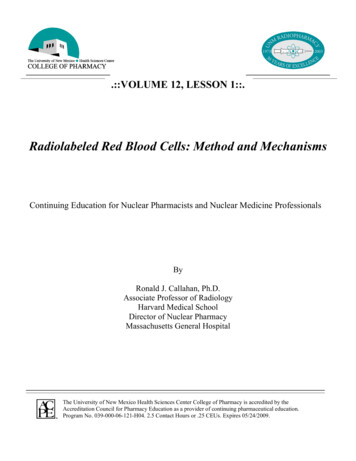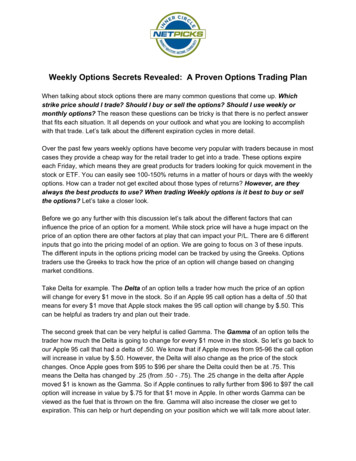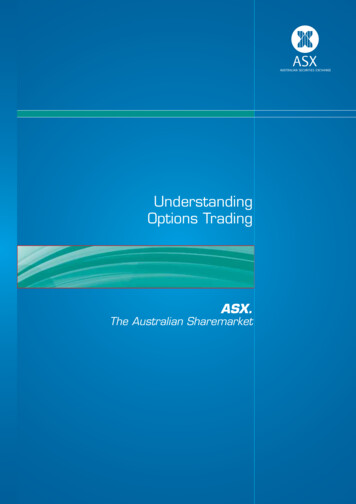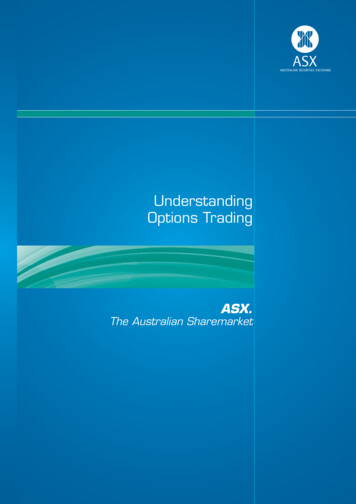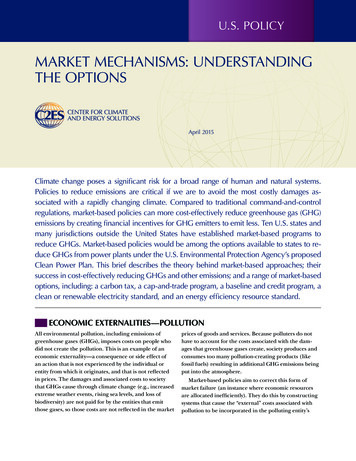
Transcription
U.S. POLICYMARKET MECHANISMS: UNDERSTANDINGTHE OPTIONSApril 2015Climate change poses a significant risk for a broad range of human and natural systems.Policies to reduce emissions are critical if we are to avoid the most costly damages associated with a rapidly changing climate. Compared to traditional command-and-controlregulations, market-based policies can more cost-effectively reduce greenhouse gas (GHG)emissions by creating financial incentives for GHG emitters to emit less. Ten U.S. states andmany jurisdictions outside the United States have established market-based programs toreduce GHGs. Market-based policies would be among the options available to states to reduce GHGs from power plants under the U.S. Environmental Protection Agency’s proposedClean Power Plan. This brief describes the theory behind market-based approaches; theirsuccess in cost-effectively reducing GHGs and other emissions; and a range of market-basedoptions, including: a carbon tax, a cap-and-trade program, a baseline and credit program, aclean or renewable electricity standard, and an energy efficiency resource standard.ECONOMIC EXTERNALITIES—POLLUTIONAll environmental pollution, including emissions ofgreenhouse gases (GHGs), imposes costs on people whodid not create the pollution. This is an example of aneconomic externality—a consequence or side effect ofan action that is not experienced by the individual orentity from which it originates, and that is not reflectedin prices. The damages and associated costs to societythat GHGs cause through climate change (e.g., increasedextreme weather events, rising sea levels, and loss ofbiodiversity) are not paid for by the entities that emitthose gases, so those costs are not reflected in the marketprices of goods and services. Because polluters do nothave to account for the costs associated with the damages that greenhouse gases create, society produces andconsumes too many pollution-creating products (likefossil fuels) resulting in additional GHG emissions beingput into the atmosphere.Market-based policies aim to correct this form ofmarket failure (an instance where economic resourcesare allocated inefficiently). They do this by constructingsystems that cause the “external” costs associated withpollution to be incorporated in the polluting entity’s
decision-making. When firms explicitly see and mustpay for the societal cost of pollution, they are able todetermine how best to meet an environmental objective.Moreover, when prices of products reflect their full environmental costs, consumers also are better able to makeinformed purchasing decisions.MARKET-BASED VERSUS COMMAND-AND-CONTROL REGULATIONSMarket-based environmental policies are a potentially attractive alternative to traditional command-and-controlregulatory programs. Command-and-control policiestypically require polluters to take specific actions toreduce emissions by installing a particular technologyor meeting a specific performance (emissions) standard.Command-and-control regulations have been criticizedas not providing the flexibility to take into considerationthat different plants face different compliance optionsand associated costs—some can do more for less, whileothers face higher costs. Moreover, traditional regulations do not provide an incentive for firms to innovate bygoing beyond the reductions required by the standard.Market-based options provide greater flexibility forfirms and seem particularly appropriate in the context ofpolicies to reduce GHG emissions. For some types of pollutants, it matters that emissions at any particular pointor region do not exceed health-related thresholds. Forthose types of pollutants, command-and-control regulation is often the appropriate policy response. BecauseGHGs are not harmful on a localized basis—they areglobally mixed in the atmosphere and do damage on aglobal scale—market-based policies that provide greatercompliance flexibility can achieve environmental objectives at lower overall costs. Beyond providing an incentivefor the use of lower emitting technologies, market-basedpolicies also provide a financial incentive for inventors and investors to develop and deploy lower-emittingtechnologies. This type of policy also leaves the privatemarket to determine which technologies will thrive andexpand. At the U.S. federal level, market-based policieshave been used to reduce sulfur dioxide emissions ata fraction of the originally estimated cost, while at thestate level they have been used successfully in renewableenergy programs and cap-and-trade programs for greenhouse gases and nitrogen oxides.EXAMPLES OF MARKET-BASED POLICY OPTIONS FOR GREENHOUSE GASEMISSIONSMarket-based environmental policies work by creatingan incentive to reduce or eliminate emissions. Underthis structure, each regulated business chooses independently how to most cost-effectively achieve the requiredpollution abatement. Notably, some companies canreduce pollution more cheaply than others (because ofthe age of their equipment or the technology they areusing), allowing them to reduce their pollution more,to compensate for those facing higher costs doing less.Taken together, the overall environmental objective willbe achieved at the lowest possible total costs. The keycriterion in determining if a policy is ‘market-based’ isthat it provides a financial incentive designed to elicit aspecific behavior from those responsible for the pollution. Some policy options are applicable as economy-2Center for Climate and Energy Solutionswide solutions where greater efficiencies can be achieved,while others are more generally targeted to a particularmarket segment or sector. The following section exploresseven major market-based policy options. (Appendix Aprovides a quick reference for the market-based optionsdescribed here.)Each of the policy options described below has theflexibility to be structured in a variety of ways to meetparticular political contexts or sets of economic challenges. Further, none of the policies, alone, is a panacea for solving the global climate crisis. For example,complementary policies aimed at research and development and programs to adapt to climate change may alsobe required. Moreover, different policy approaches maybe required depending on the specific market failure
BOX 1: UncertaintyAssessing the cost to society from pollution is often difficult. While some damages caused by pollution are relatively easyto estimate in monetary terms, others are much more challenging to quantify. For example, if pollution causes a reductionin the fish population for a commercial fishery, we can estimate the damages based on the lost value of the fish at marketprices. If, however, wetlands are destroyed or a species becomes extinct, it is not clear how society should assign a specificeconomic value to that loss. Other complications make it difficult to put a precise dollar figure on the costs imposed bya unit of pollution. They involve questions of how damages that apply to future generations should be valued in today’sdecisions, and how to quantify consequences when there is a range of possible outcomes or the potential exists for a lowprobability, high-impact event.that needs to be addressed (e.g., capturing externalities,splitting incentives between building developer and occupant). To the extent the introduction of these policies proceeds in a piecemeal fashion, it is important toremember that market-based policies are more efficientthe more businesses and sectors they cover. With moreoptions for reductions, it is more likely that some will beless expensive to achieve—thus reducing overall costsfor a given level of emissions reduction. For this reason,designing more limited market-based policies (e.g.,directed at a specific sector or state) that can later be interconnected with other market-based emission can helpreduce the costs of meeting an environmental objective.TAXES AND SUBSIDIESThe most basic form of a market-based policy is a tax thatsets a price on each unit of pollution. By introducing atax on pollution, the entity producing the pollution incurs an additional cost based on the amount of pollutionemitted. Because of this, the entity has an incentive toreduce the pollution produced by changing its processesor adopting new technology. In this way, the tax providesa continuous incentive for innovation; the more emissions can be reduced, the less tax a company would pay.Ideally, the cost of the tax would be set equal to the costto society that the pollution creates. Ascertaining thiscost, however, is not always easy. (See Box 1.) Taxes toreduce GHGs can come in two broad forms: an emissionstax, which taxes firms directly based on the GHG emissions they produce, and a tax on goods or services thatare generally GHG-intensive—an example would be acarbon tax on gasoline, see Box 2.Subsidy programs that provide government assistance(or tax credits) for specific types of low-emitting activitiesor technology applications function in a similar way totaxes, in that they provide a specific financial mechanismto motivate a particular environmentally beneficial outcome (they are, in fact, negative taxes). Subsidy programsare by their nature a “cost” to taxpayers in general butthey are often more popular than new taxes, being seenas a carrot rather than a stick. The federal investmenttax credit for solar and the former federal productiontax credit for wind are examples where tax breaks areused to incentivize the deployment of renewable energytechnologies. These technologies reduce greenhouse gasemissions to the extent that they displace fossil energygeneration.CAP-AND-TRADE PROGRAMAnother market-based mechanism is a cap-and-tradeprogram. This approach is “quantity-based.” Instead ofsetting a price on each unit of pollution, the regulatoryauthority determines a total quantity of pollution (a“cap”) that will be allowed. Companies buy and sell emission allowances (tradable certificates that allow a certainamount of emissions) based on their needs. The limitednumber of these allowances creates scarcity. The requirement that regulated businesses hold enough allowancesto cover their emissions ensures the cap is met andcreates demand for the allowances.1 If it is less costly fora company to reduce emissions than to buy allowances,the company will reduce its own emissions. Similarly, ifa company can reduce emissions below its requirements,so it has excess allowances, those allowances can then bebanked for future use or sold in an open market to a firmthat finds it more difficult (costly) to reduce emissions.Because there is a scarcity of allowances and businesses can trade them, the allowances are valuable andlead to a price on greenhouse gas emissions. This priceprovides a continuous incentive to reduce emissions andinnovate since firms can save money if they reduce theiremissions and avoid buying allowances. Some firms mayMarket Mechanisms: Understanding the Options3
Box 2: Choosing Between Price-Based and Quantity-Based Market PoliciesThe trade-off between price-based (e.g., carbon tax) approaches and quantity-based (e.g., cap and trade) approaches iseither greater compliance cost certainty or greater environmental certainty. Setting an explicit price on a unit of pollutionoffers a high degree of price certainty for the regulated businesses. However, while the compliance cost is more certain,the resulting level of pollution reduction overall is less certain because each company will respond differently to the priceset by the tax. For example, a tax of 1 per gallon of gas could cause Company A to reduce its gasoline consumption by20 percent but cause Company B to reduce its consumption by only 1 percent. The level of the reduction is difficult toknow in advance and the level of the tax may need to be adjusted over time to achieve a specific emission reduction goal.In contrast, a quantity-based market policy provides certainty about the environmental outcome because only a limitednumber of pollution allowances are distributed or auctioned. In this case, while the environmental outcome is certain, thecost to firms for emitting pollution is uncertain (particularly at the outset of the program) and will be determined by themarket price for allowances. Real-world market-based policy proposals, however, are not so “black and white” and can bedesigned with policy components that create more certainty for both price and quantity. For example, programs in California and the Regional Greenhouse Gas Initiative (RGGI) have included price floors and allowance reserve (that acts like aprice ceiling)—to give more compliance cost certainty.2actually be able to raise revenue by selling their excessallowances. This is particularly true if firms are allocatedsome number of allowances for free—allowances aregrandfathered to existing emitters. Since the allowancesare valuable, how they are distributed has implications.If they are given away for free, this is a financial benefitto the recipients. If they are auctioned, the resultingrevenue can be channeled to specific groups or uses (seeBox 3). As discussed below, cap and trade has been successfully used to reduce ozone-depleting substances under the Montreal Protocol, acid rain under the Clean AirAct, and greenhouse gases under programs in Europe, inCalifornia and in nine U.S. states in the Northeast andMid-Atlantic.The program to remove lead from gasoline in the1980s, for example, used a rate-based baseline-and-creditapproach to achieve reductions at much lower cost thanoriginally anticipated (see below). More recently, in 2007,Alberta, Canada implemented a baseline-and-creditapproach as part of its climate program. The programrequires large emitters to either: reduce their emissionintensity—i.e., emissions per unit of reduction—by 12percent, buy emission performance credits from other facilities in Alberta, buy offsets from other firms in Albertathat have voluntarily reduced their emissions, or pay
Market Mechanisms: Understanding the Options 3 that needs to be addressed (e.g., capturing externalities, splitting incentives between building developer and oc-cupant). To the extent the introduction of these poli-cies proceeds in a piecemeal fashion, it is important to remember that market-based policies are more efficient the more businesses and sectors they cover. With more options for .


